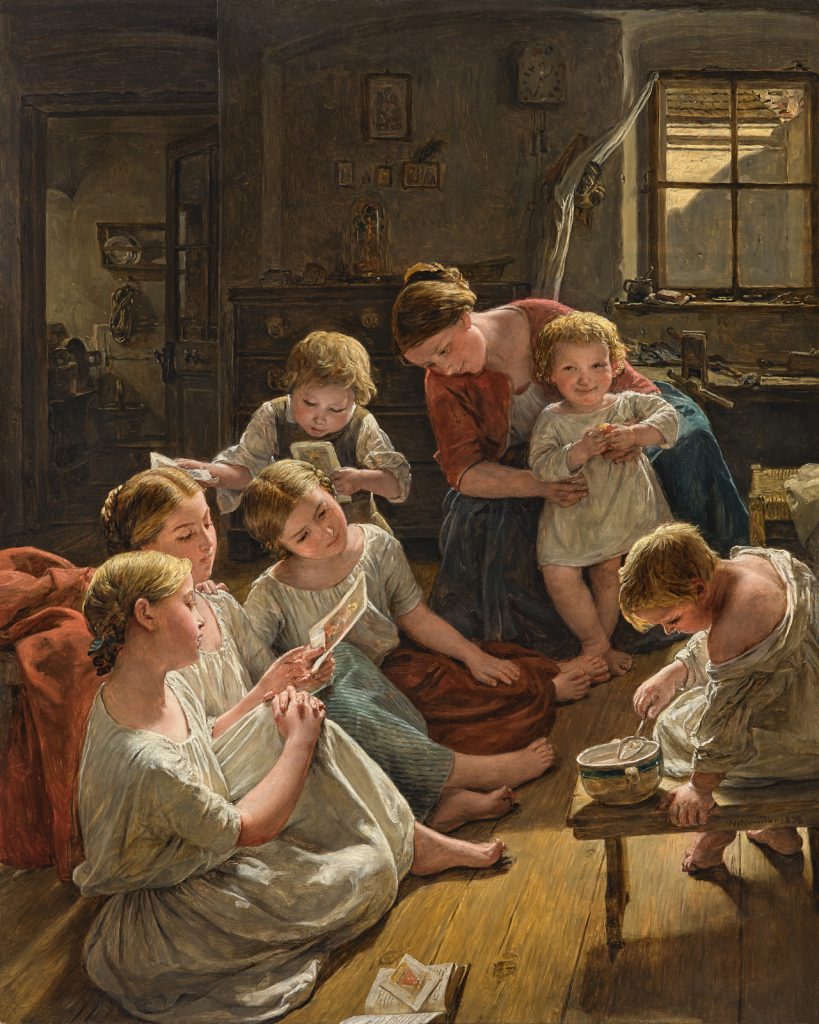Ferdinand Georg Waldmüller
(1793 - Vienna - 1865)
Home Education, 1846
Oil on panel, 55.5 x 44.5 cm
Signed and dated lower right Waldmüller 1846
Provenance:
Munich, Neumeister, auction 266, 18 March 1992, lot 680, plate XXXIII
Kunsthandlung R. Hofstätter, Vienna (1993)
Private collection, Vienna
Exhibited:
Dresden, Academy of Arts, 1861 (probably Feuchtmüller no. 1019, a later version of the present painting)
Katalog einer Sammlung von Ölgemälden, besonders aber einer reichen Auswahl Bilder vom F. G. Waldmüller, pens. Professor der k.k. Akademie der bildenden Künste, welche den 11., 12. und 13. Mai d.J. in Löschers Salon, Kärnthnerstrasse, Bürgerspital, freiwillig öffentlich versteigert wird, Vienna, Löschers Salon, 11-13 May 1863, n.n. (conceivably Feuchtmüller no. 1019)
Literature:
Rupert Feuchtmüller, Ferdinand Georg Waldmüller 1793-1865, Leben – Schriften – Werke, Vienna and Munich 1996, p. 504, no. 863 (a dating of 1853 is given)
Here, real sunlight illuminates the figures of these sweet, youthful beings and the entire composition is such that we would be hard pressed to name any painting in the exhibition that we would rather own (Breslauer Zeitung reviewing the second version of this painting from 1860 shown at the 1861 exhibition in Dresden).[1]
Genre scenes occupied an important place in Waldmüller’s later oeuvre. A man of humble origins, he was driven more by rural themes than subjects drawn from a bourgeois milieu. In this panel, he focuses on interpersonal relationships such as charity, rather than on the hardships of work. In scenes depicting the ‘authentic lives of simple folk’ he succeeded in representing his ideal of the felicitous unity of man and nature.
In the present painting Waldmüller depicts a Sunday morning family idyll. A young mother sits amid her six children in a sparsely furnished abode which serves both as a dwelling and a workshop guaranteeing the family a scant livelihood. The woman has her youngest child on her lap, while the five remaining children are immersed in the contemplation of devotional images. A book lies open on the floor beside the older children seated at the left. One of the younger children stirs his porridge.
Waldmüller’s moral appeal to a society that deprived children of educational opportunities by providing only six years of compulsory schooling is unmistakable. In the early industrial period, factories and mines were hungry for workers and not even children were spared. Child labor was a bleak reality. The far-sighted young mother in Waldmüller’s painting is investing in her children’s future – she hopes to secure them a livelihood by educating them.
The careful modeling and precision of Waldmüller’s painting technique shows a debt to the Old Masters. He would have had ample opportunity to study and make copies after the works of Hans Holbein the Younger and the Dutch seventeenth-century figurative painters in the Imperial Collections. In this painting he pays particular attention to the naturalistic depiction of light and his treatment of the extraordinary variety of textures is masterly.
In his later career, as recognition of his importance spread, Waldmüller began to produce versions and variants of many of his paintings This is evidence of the popularity of his work not only in Vienna but abroad. The present painting is his first version of the subject. A later version dating from 1860 is recorded (Feuchtmüller no. 1019).
Waldmüller’s talent was soon recognized. He enrolled at the Vienna Academy at the very young age of fourteen. Always a rebel – a characteristic that did not simplify his life – he vehemently pursued his own ideas. In the bitter debate about Realism within contemporary artistic circles he unequivocally supported the truthful imitation of nature beyond the pictorial conventions of the time. His unbending spirit and the polemic texts about reform[2] that he wrote while teaching at the Vienna Academy repeatedly caused him severe problems, ultimately leading to his suspension and early dismissal. Not until 1864, just one year before his death, was he awarded a pension and hence offered at least financial rehabilitation.
In addition to the Emperors of Austria, Waldmüller portrayed the country’s different classes: the nobility, the emerging bourgeoisie and the ordinary people living in poverty. His work is driven by a striving for truth. In his genre paintings, the striving for truth also results in social criticism. Particularly in his late work, he repeatedly alludes to the social injustice and poverty faced by large segments of the population.
For a long time, posterity failed to recognise the modernity of Waldmüller’s art, seeing it solely as a product of the Biedermeier movement with its traditional values. Only in the twentieth century did he receive the recognition he deserved. His realism and his gifts as an observer prefigure the striking portraits produced by the Viennese Modernists in the years around 1900.[3] Today, Waldmüller ranks as one of Austria’s leading nineteenth-century painters.[4] His works are to be found in the great museums of Europe, Russia and North America.
[1] The review probably refers to a later version of the present painting, very possibly the 1860 version (Feuchtmüller no. 1019) which may have been shown at the 1861 exhibition in Dresden.
[2] Waldmüller’s complete critical writings are published in Rupert Feuchtmüller, Ferdinand Georg Waldmüller 1793-1865, Leben – Schriften – Werke, Vienna and Munich 1996, pp. 329-413; Arthur Roessler and Gustav Pisko, Ferdinand Georg Waldmüller. Sein Leben, sein Werk und seine Schriften, Vienna 1907, I.
[3] Facing the Modern: The Portrait in Vienna 1900, Gemma Blackshaw (ed.), exhib. cat., London, The National Gallery, October 2013-January 2014, London 2013.
[4] Sabine Grabner, ‛Ferdinand Georg Waldmüller – Künstler und Rebell’, in Agnes Husslein-Arco and Sabine Grabner (eds.), Ferdinand Georg Waldmüller, exhib. cat., Paris, Musée du Louvre, February-May 2009 and Vienna, Österreichische Galerie Belvedere, June-October 2009, p. 13.

